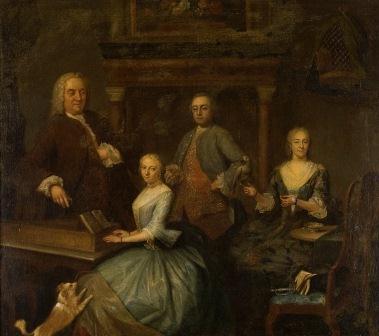In a letter dated 20 December 2004, the State Secretary for Culture, Education and Science asked the Restitutions Committee to issue a recommendation regarding the application for the restitution of the painting A Family Portrait by J.M. Quinkhard (NK 2079). The painting was, at that point, on loan to the Arnhem Museum of Modern Art, where it was held in the museum’s depot. The application for restitution came in response to a letter from the Origins Unknown Agency addressed to various members of Rosa Jacobson-Granaat’s family, requesting information about the painting.
Prior to the war or in any event as from 1921, the Quinkhard painting was part of the Granaat family art collection. Rosa Jacobson-Granaat, born in Amsterdam on 19 May 1888, most likely inherited the painting in 1928. The most recent art historical source conclusively proving that Rosa Jacobson-Granaat owned the painting dates from 1932. Rosa Jacobson-Granaat was married to Abraham Simeon Jacobson and had one adopted daughter. During the first years of the war, the couple, who possessed several valuable works of art, resided on the Minervalaan in Amsterdam. After going into hiding on a farm, they were arrested and transported from Westerbork transit camp to Auschwitz in early September 1944, where they were killed a few days later.
During the war, the Jacobson-Granaat family possessions, including an unknown number of paintings, were acquired by the occupying forces in number of ways. For instance, the couple’s household effects were removed after their arrest and several works of art that the couple had placed in storage during the war were confiscated and moved to Germany. Whether A Family Portrait by J.M. Quinkhard was among the works of art looted in the manner described above cannot be established with any certainty. It was demonstrated, however, that in 1944, the painting was acquired by a Dutch trader who sold it for NLG 25,000 to Ernst Göpel, a German, for the Führermuseum in Linz, in June of that year.
The Committee was therefore faced with the question of whether it was sufficiently plausible that Rosa Jacobson-Granaat had involuntarily lost possession of the claimed painting during the occupation and had not sold it before then. The Committee investigated whether there was any evidence indicating that the painting may have been sold before the start of war. This evidence was not found. The Committee further noted that the work of art was described in the art historical literature, thereby increasing the likelihood that written evidence of its sale during the 1932-1944 period would have been found. Moreover, the Committee attached importance to a statement made by a great-niece of Rosa Jacobson-Granaat:
‘This week, I saw the photocopy of the painting ‘A Family Portrait’. As a young girl, I often visited my aunt and uncle, Rosa and Abraham Jacobson. I’m fairly certain that I saw this painting in their home. As a child, I admired the painting’s beauty. Of course, this was a long time ago (circa 1938 to circa 1941), but I’m certain my memory is not playing tricks on me.’
On 6 March 2006, the Restitutions Committee advised the State Secretary to return the painting A Family Portrait by J.M. Quinkhard to the heirs of Rosa Jacobson-Granaat. In a decision taken on 5 April 2006, the State Secretary adopted the recommendation.
